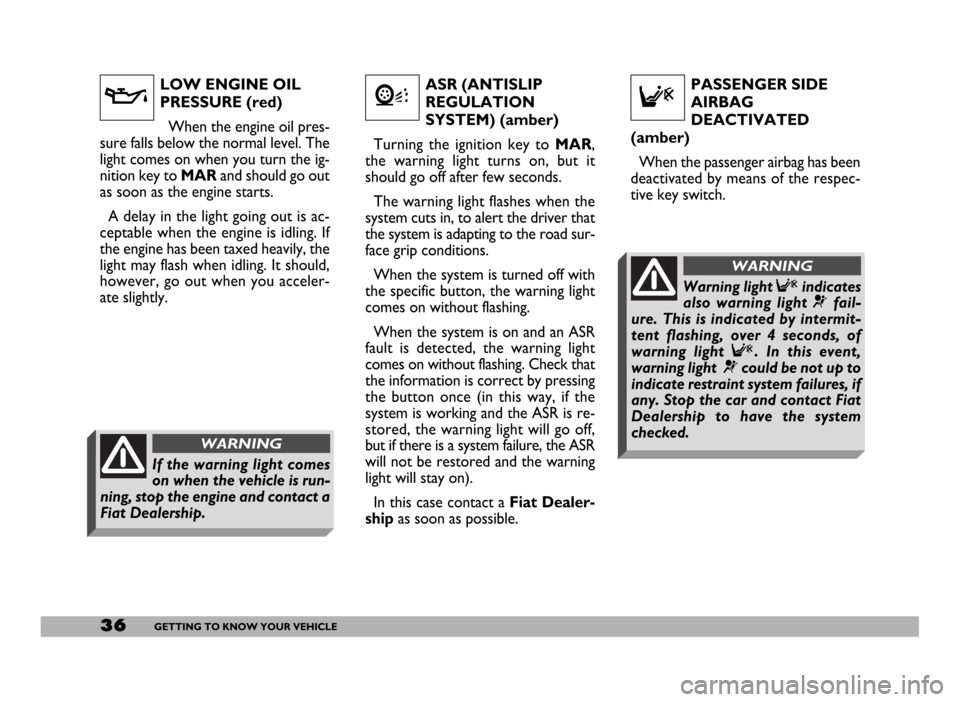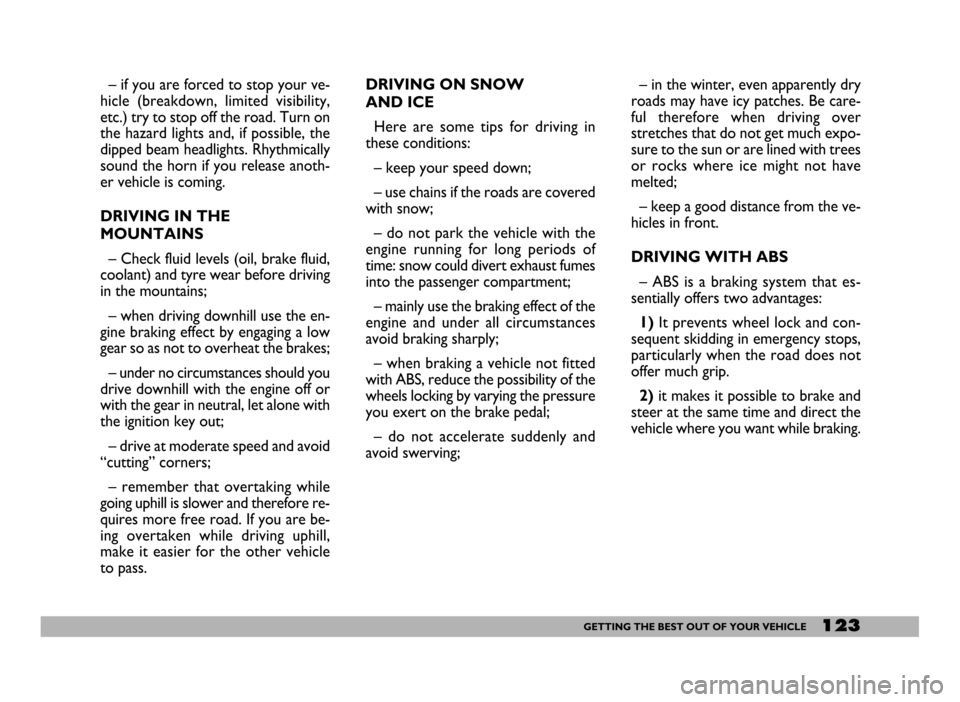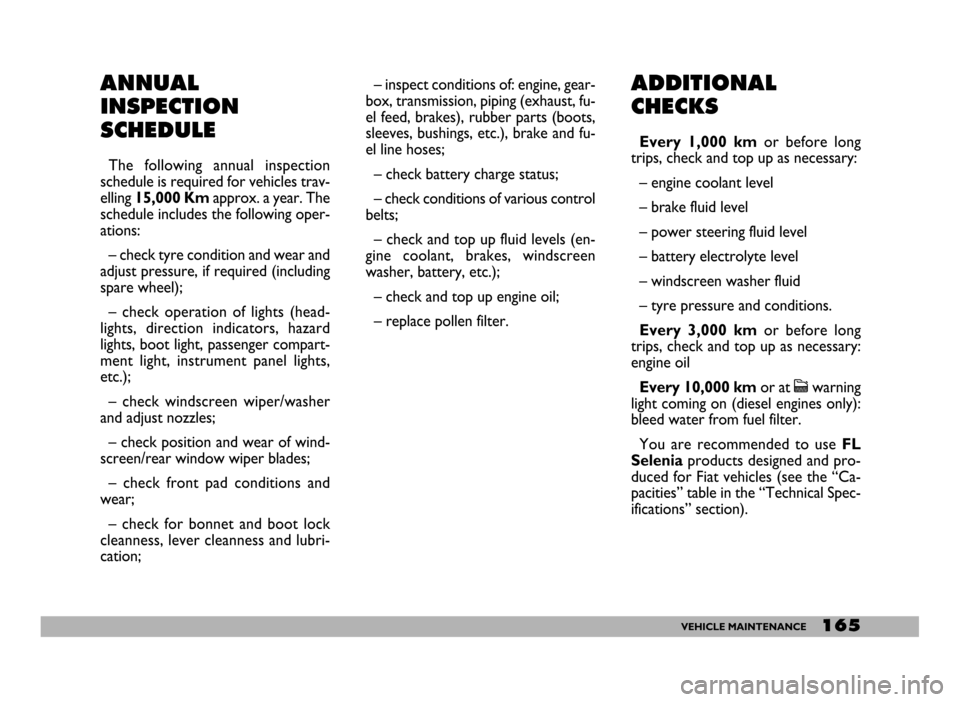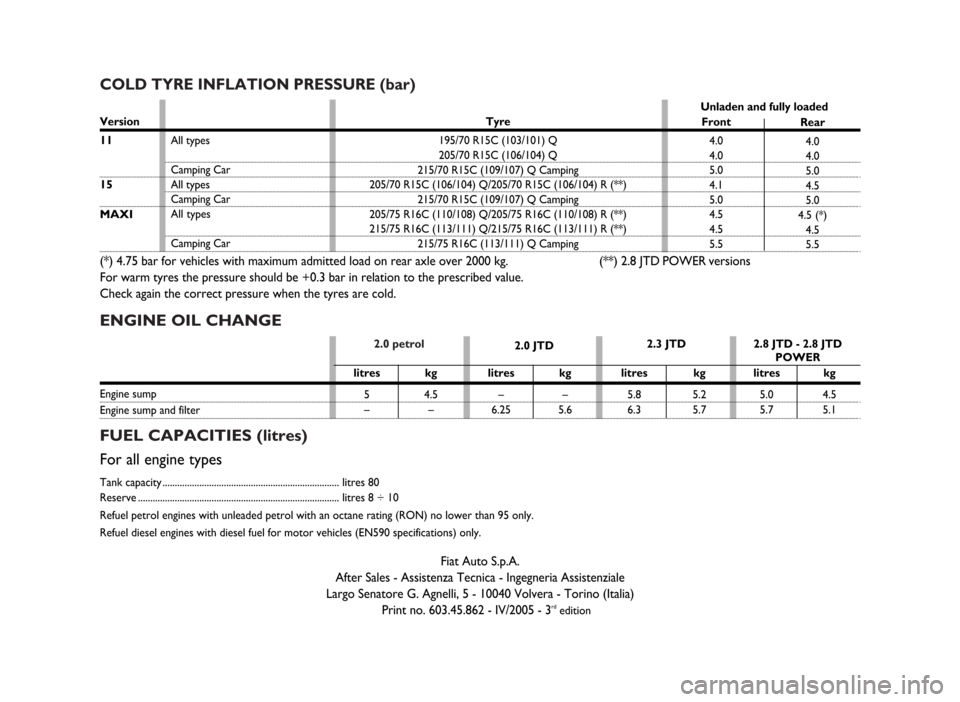low oil pressure FIAT DUCATO 244 2005 3.G Owners Manual
[x] Cancel search | Manufacturer: FIAT, Model Year: 2005, Model line: DUCATO 244, Model: FIAT DUCATO 244 2005 3.GPages: 258, PDF Size: 4.05 MB
Page 37 of 258

36GETTING TO KNOW YOUR VEHICLE
LOW ENGINE OIL
PRESSURE (red)
When the engine oil pres-
sure falls below the normal level. The
light comes on when you turn the ig-
nition key to MARand should go out
as soon as the engine starts.
A delay in the light going out is ac-
ceptable when the engine is idling. If
the engine has been taxed heavily, the
light may flash when idling. It should,
however, go out when you acceler-
ate slightly.vASR (ANTISLIP
REGULATION
SYSTEM) (amber)
Turning the ignition key to MAR,
the warning light turns on, but it
should go off after few seconds.
The warning light flashes when the
system cuts in, to alert the driver that
the system is adapting to the road sur-
face grip conditions.
When the system is turned off with
the specific button, the warning light
comes on without flashing.
When the system is on and an ASR
fault is detected, the warning light
comes on without flashing. Check that
the information is correct by pressing
the button once (in this way, if the
system is working and the ASR is re-
stored, the warning light will go off,
but if there is a system failure, the ASR
will not be restored and the warning
light will stay on).
In this case contact a Fiat Dealer-
shipas soon as possible.PASSENGER SIDE
AIRBAG
DEACTIVATED
(amber)
When the passenger airbag has been
deactivated by means of the respec-
tive key switch.
FV
If the warning light comes
on when the vehicle is run-
ning, stop the engine and contact a
Fiat Dealership.
WARNING
Warning light Findicates
also warning light ¬fail-
ure. This is indicated by intermit-
tent flashing, over 4 seconds, of
warning light F. In this event,
warning light ¬could be not up to
indicate restraint system failures, if
any. Stop the car and contact Fiat
Dealership to have the system
checked.
WARNING
Page 118 of 258

117GETTING THE BEST OUT OF YOUR VEHICLE
CONSTRUCTION FEATURES
DUCATO automatic gearbox is con-
trolled electronically with four for-
ward gears and reverse.
It is controlled by an electronic con-
trol unit which handles:
– the torque distributor;
– gearshifting;
– specific programmes.
The gearbox is coupled with a flow
power torque distributor with piloted
antislip device which makes it possible
to obtain demultiplication ratios.
The characteristic of this gearbox
which works without idle gear enables:
– higher compactness and weight re-
duction;
– improved output due to less fric-
tion;
– lower stress of transmission com-
ponents.GENERAL FEATURES
Electronic gearbox control makes it
possible to obtain gearshifting suited
to momentary engine characteristics
with a certain elasticity.
The electronic control unit has the
following task:
– adapting the oil pressure for
gearshifting to the engine torque;
– activating safety functions;
– defining the manual gearshifting
programme;
– system diagnostics.
For controlling these operating log-
ics the control unit uses the follow-
ing signals:
– engine rpm;
– engine temperature;
– engine torque;
– vehicle speed;
– gearbox oil temperature;– gearshift lever position;
– accelerator pedal position;
– brake pedal position.
The control unit also communicates
with the injection system electronic
control unit.
Conditions of use analysed by
the control unit
The control unit analyses each single
condition of use of the vehicle, dis-
criminating it on the basis of the sig-
nals received from the various sensors.
Analysed conditions are the follow-
ing:
– starting (position/accelerator ped-
al changing speed);
– acceleration (accelerator pedal
completely pushing down speed);
– full load (number of engine full load
kickdown signals or position mainte-
nance time);
Page 124 of 258

123GETTING THE BEST OUT OF YOUR VEHICLE
– if you are forced to stop your ve-
hicle (breakdown, limited visibility,
etc.) try to stop off the road. Turn on
the hazard lights and, if possible, the
dipped beam headlights. Rhythmically
sound the horn if you release anoth-
er vehicle is coming.
DRIVING IN THE
MOUNTAINS
– Check fluid levels (oil, brake fluid,
coolant) and tyre wear before driving
in the mountains;
– when driving downhill use the en-
gine braking effect by engaging a low
gear so as not to overheat the brakes;
– under no circumstances should you
drive downhill with the engine off or
with the gear in neutral, let alone with
the ignition key out;
– drive at moderate speed and avoid
“cutting” corners;
– remember that overtaking while
going uphill is slower and therefore re-
quires more free road. If you are be-
ing overtaken while driving uphill,
make it easier for the other vehicle
to pass.DRIVING ON SNOW
AND ICE
Here are some tips for driving in
these conditions:
– keep your speed down;
– use chains if the roads are covered
with snow;
– do not park the vehicle with the
engine running for long periods of
time: snow could divert exhaust fumes
into the passenger compartment;
– mainly use the braking effect of the
engine and under all circumstances
avoid braking sharply;
– when braking a vehicle not fitted
with ABS, reduce the possibility of the
wheels locking by varying the pressure
you exert on the brake pedal;
– do not accelerate suddenly and
avoid swerving;– in the winter, even apparently dry
roads may have icy patches. Be care-
ful therefore when driving over
stretches that do not get much expo-
sure to the sun or are lined with trees
or rocks where ice might not have
melted;
– keep a good distance from the ve-
hicles in front.
DRIVING WITH ABS
– ABS is a braking system that es-
sentially offers two advantages:
1) It prevents wheel lock and con-
sequent skidding in emergency stops,
particularly when the road does not
offer much grip.
2) it makes it possible to brake and
steer at the same time and direct the
vehicle where you want while braking.
Page 166 of 258

165VEHICLE MAINTENANCE
ANNUAL
INSPECTION
SCHEDULE
The following annual inspection
schedule is required for vehicles trav-
elling 15,000 Kmapprox. a year. The
schedule includes the following oper-
ations:
– check tyre condition and wear and
adjust pressure, if required (including
spare wheel);
– check operation of lights (head-
lights, direction indicators, hazard
lights, boot light, passenger compart-
ment light, instrument panel lights,
etc.);
– check windscreen wiper/washer
and adjust nozzles;
– check position and wear of wind-
screen/rear window wiper blades;
– check front pad conditions and
wear;
– check for bonnet and boot lock
cleanness, lever cleanness and lubri-
cation;– inspect conditions of: engine, gear-
box, transmission, piping (exhaust, fu-
el feed, brakes), rubber parts (boots,
sleeves, bushings, etc.), brake and fu-
el line hoses;
– check battery charge status;
– check conditions of various control
belts;
– check and top up fluid levels (en-
gine coolant, brakes, windscreen
washer, battery, etc.);
– check and top up engine oil;
– replace pollen filter.
ADDITIONAL
CHECKS
Every 1,000 km or before long
trips, check and top up as necessary:
– engine coolant level
– brake fluid level
– power steering fluid level
– battery electrolyte level
– windscreen washer fluid
– tyre pressure and conditions.
Every 3,000 km or before long
trips, check and top up as necessary:
engine oil
Every 10,000 kmor at cwarning
light coming on (diesel engines only):
bleed water from fuel filter.
You are recommended to use FL
Seleniaproducts designed and pro-
duced for Fiat vehicles (see the “Ca-
pacities” table in the “Technical Spec-
ifications” section).
Page 257 of 258

2.0 petrol
COLD TYRE INFLATION PRESSURE (bar)
ENGINE OIL CHANGE
FUEL CAPACITIES (litres)
For all engine types
Tank capacity ........................................................................ litres 80
Reserve .................................................................................. litres 8 ÷ 10
Refuel petrol engines with unleaded petrol with an octane rating (RON) no lower than 95 only.
Refuel diesel engines with diesel fuel for motor vehicles (EN590 specifications) only.
Version
11
15
MAXI
(*) 4.75 bar for vehicles with maximum admitted load on rear axle over 2000 kg. (**) 2.8 JTD POWER versions
For warm tyres the pressure should be +0.3 bar in relation to the prescribed value.
Check again the correct pressure when the tyres are cold.
Unladen and fully loaded
Rear
4.0
4.0
5.0
4.5
5.0
4.5 (*)
4.5
5.5 Front
4.0
4.0
5.0
4.1
5.0
4.5
4.5
5.5 All types
Camping Car
All types
Camping Car
All types
Camping CarTyre
195/70 R15C (103/101) Q
205/70 R15C (106/104) Q
215/70 R15C (109/107) Q Camping
205/70 R15C (106/104) Q/205/70 R15C (106/104) R (**)
215/70 R15C (109/107) Q Camping
205/75 R16C (110/108) Q/205/75 R16C (110/108) R (**)
215/75 R16C (113/111) Q/215/75 R16C (113/111) R (**)
215/75 R16C (113/111) Q Camping
2.8 JTD - 2.8 JTD
POWER
litres
5
–kg
4.5
–kg
–
5.6litres
5.0
5.7 kg
5.2
5.7kg
4.5
5.1 2.3 JTD
Fiat Auto S.p.A.
After Sales - Assistenza Tecnica - Ingegneria Assistenziale
Largo Senatore G. Agnelli, 5 - 10040 Volvera - Torino (Italia)
Print no. 603.45.862 - IV/2005 - 3
rdedition 2.0 JTD
litres
–
6.25litres
5.8
6.3
Engine sump
Engine sump and filter